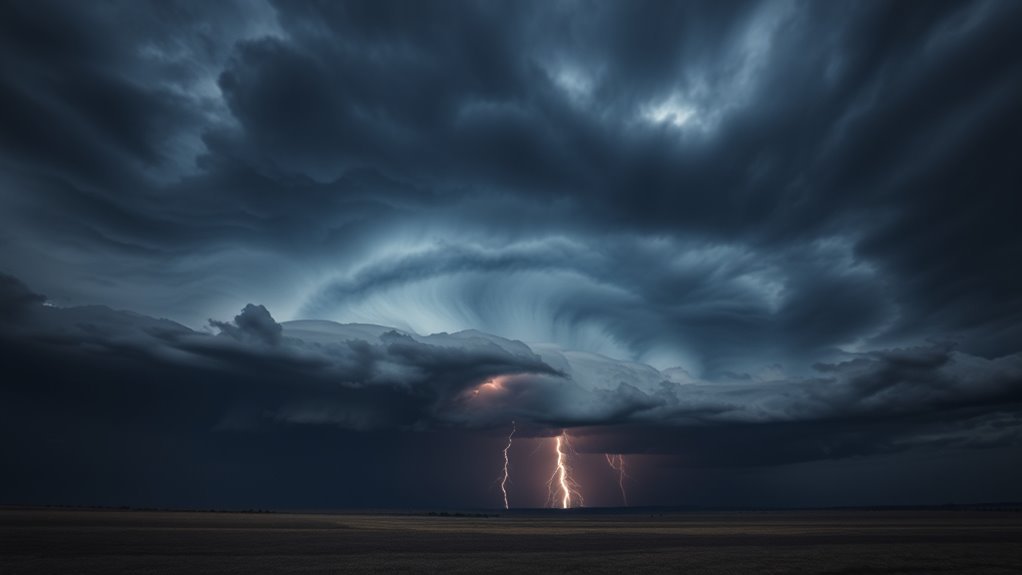Squall lines are elongated bands of severe thunderstorms, producing widespread impacts such as strong winds and heavy rainfall, often extending for hundreds of miles. In contrast, isolated squalls are independent, short-lived storms that can rapidly intensify, leading to localized severe weather events. For instance, squall lines have generated tornadoes and extreme winds, while isolated squalls have caused intense conditions in specific areas. Understanding these phenomena further reveals their distinct characteristics and notable examples.
Main Points
- Squall lines are organized bands of thunderstorms, while isolated squalls are individual storms that develop independently.
- Squall lines produce widespread severe weather impacts, whereas isolated squalls lead to localized severe conditions.
- Squall lines typically last longer and cover larger areas compared to the short-lived nature of isolated squalls.
- Predictability of squall lines is higher due to their association with cold fronts, unlike the unpredictable formation of isolated squalls.
- Real-world examples include squall lines causing tornadoes in the southeast and isolated squalls producing intense winds in the Great Plains.
Defining Squall Lines
Squall lines are defined as elongated bands of severe thunderstorms that can produce strong winds, heavy rainfall, and sometimes hail. These formations typically develop along cold fronts and are marked by their linear structure, which can extend for hundreds of miles.
The organization of squall lines allows them to sustain intense weather conditions over a prolonged period. They often form during the shift between warm, moist air and cooler, denser air, leading to rapid vertical development of thunderstorms.
Squall lines can travel long distances and may produce dangerous weather phenomena, including damaging winds and flash flooding. They differ from isolated thunderstorms, which occur independently and may not exhibit the same level of organization or longevity.
Understanding the dynamics of squall lines is vital for meteorologists, as their impact can greatly affect local weather conditions and safety.
Characteristics of Squall Lines

Thunderstorm systems known as squall lines are distinguished by several key characteristics that set them apart from other forms of severe weather. Typically, they form as elongated bands of storms, stretching for hundreds of miles, often associated with a cold front.
These lines exhibit a continuous structure, featuring multiple, closely spaced thunderstorms that can produce heavy rainfall, strong winds, and even hail.
Squall lines often develop in a linear fashion, with the most intense activity occurring at the leading edge, known as the gust front. This front can generate considerable downdrafts, resulting in strong wind gusts that may exceed 50 knots.
Additionally, squall lines are capable of producing severe weather phenomena, including tornadoes, particularly in their southern regions. The duration of these systems can vary, but they generally persist longer than isolated thunderstorms, providing a prolonged threat to affected areas.
Understanding Isolated Squalls
While squall lines are defined by their linear formation, isolated squalls present a different phenomenon, occurring as discrete, individual storms. These isolated squalls can develop independently and are often marked by rapid intensification. They may arise from a variety of atmospheric conditions, including localized heating or disturbances in the atmosphere.
Unlike squall lines, which can stretch for hundreds of miles, isolated squalls are typically short-lived and confined to a smaller geographic area.
Meteorologically, isolated squalls can form in various settings, including ahead of cold fronts or within unstable air masses. Their unpredictable nature often leads to localized severe weather, such as intense winds, heavy rainfall, and even hail.
While they may not cover extensive areas, the impact of isolated squalls can be notable, particularly in regions unprepared for sudden weather changes. Understanding these storms is essential for accurate forecasting and public safety measures.
Characteristics of Isolated Squalls

Isolated squalls exhibit distinctive characteristics that set them apart from other storm types. These phenomena typically occur as singular, localized events rather than part of a larger system.
Isolated squalls are often defined by rapid onset, with intense winds and heavy precipitation emerging suddenly. They can occur in various weather conditions, including warm, humid air preceding a cold front.
The duration of an isolated squall is generally short-lived, often lasting less than an hour, but the intensity can be severe, leading to hazardous conditions.
These squalls may produce strong gusts, sometimes exceeding 50 knots, causing damage to structures and trees. Additionally, they are frequently accompanied by lightning and hail.
The unpredictability of isolated squalls makes them particularly challenging for forecasters, as they can develop quickly and without warning, impacting areas that may not be experiencing any other storm activity.
Key Differences Between Squall Lines and Isolated Squalls
The fundamental differences between squall lines and isolated squalls lie in their formation, structure, and impact.
Squall lines are organized bands of thunderstorms that develop along a cold front, creating a continuous line of severe weather. These systems often produce widespread heavy rainfall, strong winds, and lightning.
In contrast, isolated squalls form independently and can occur in the absence of a larger weather system. They are typically single-cell thunderstorms and may produce localized heavy rainfall and strong gusts but do not usually result in the extensive impacts seen with squall lines.
Additionally, squall lines can persist over larger areas and last for several hours, while isolated squalls are shorter-lived and localized.
The predictability of squall lines is generally higher due to their association with frontal systems, whereas isolated squalls can be more challenging to forecast due to their spontaneous nature.
Understanding these differences is essential for effective weather prediction and public safety.
Real-World Examples of Squall Lines
Squall lines can produce dramatic and impactful weather events, making them notable phenomena in meteorology. One important example occurred on April 12, 2020, when a squall line swept across the southeastern United States, generating severe thunderstorms and tornadoes. This event led to widespread damage in states such as Alabama and Mississippi, showcasing the destructive potential of squall lines.
Another notable instance took place on June 18, 2021, when a squall line formed in the Midwest, producing straight-line winds exceeding 90 miles per hour. This resulted in downed trees and power outages across several states, affecting thousands of residents.
Additionally, the squall line that impacted the Eastern Seaboard on March 2, 2023, brought heavy rainfall and flash flooding, emphasizing the diverse impacts these weather phenomena can have.
Each of these examples illustrates the important threats posed by squall lines in various regions.
Real-World Examples of Isolated Squalls
How do isolated squalls manifest in different environments?
Isolated squalls can develop in various geographic locations, demonstrating distinct characteristics. For instance, in the Great Plains of the United States, isolated squalls often occur during summer months, producing intense winds and brief but heavy rainfall. These storms can lead to localized flooding and damage, primarily due to their rapid onset.
In coastal regions, such as the Gulf of Mexico, isolated squalls arise from warm, moist air interacting with cooler sea breezes. These squalls can bring sudden gusts and thunderstorms, impacting marine activities.
Moreover, mountainous areas may experience isolated squalls due to orographic lifting, resulting in localized precipitation and wind shifts. An example includes isolated squalls in the Sierra Nevada, where steep terrain improves storm development.
In general, isolated squalls exhibit variability influenced by environmental factors, offering unique challenges to weather forecasting and safety measures.
Common Questions
How Do Squalls Affect Aviation Safety and Operations?
Squalls can greatly impact aviation safety and operations by causing sudden, severe wind shifts, turbulence, and reduced visibility. Pilots must be vigilant, adjusting flight plans and approaches to mitigate risks associated with these unpredictable weather phenomena.
What Precautions Should Boaters Take During Squall Events?
During squall events, boaters should secure all gear, monitor weather updates, and seek shelter if necessary. Reducing speed and maintaining a steady course can also improve stability, helping guarantee safety amidst sudden weather changes.
Can Squall Lines Produce Tornadoes or Hail?
Squall lines, defined by their organized structure, can indeed produce severe weather phenomena such as tornadoes and hail. Meteorologists monitor these systems closely due to their potential for rapid intensification and dangerous conditions.
How Can Technology Improve Squall Prediction Accuracy?
Advancements in meteorological technology, including improved radar systems, machine learning algorithms, and satellite imagery, greatly improve squall prediction accuracy by providing real-time data analysis, facilitating early warnings, and enabling more precise tracking of severe weather patterns.
Are Squalls More Common in Certain Geographic Regions?
Certain geographic regions, particularly coastal and tropical areas, experience squalls more frequently due to climatic conditions. Factors such as temperature gradients and humidity levels contribute to the formation of these intense weather phenomena in specific locations.

